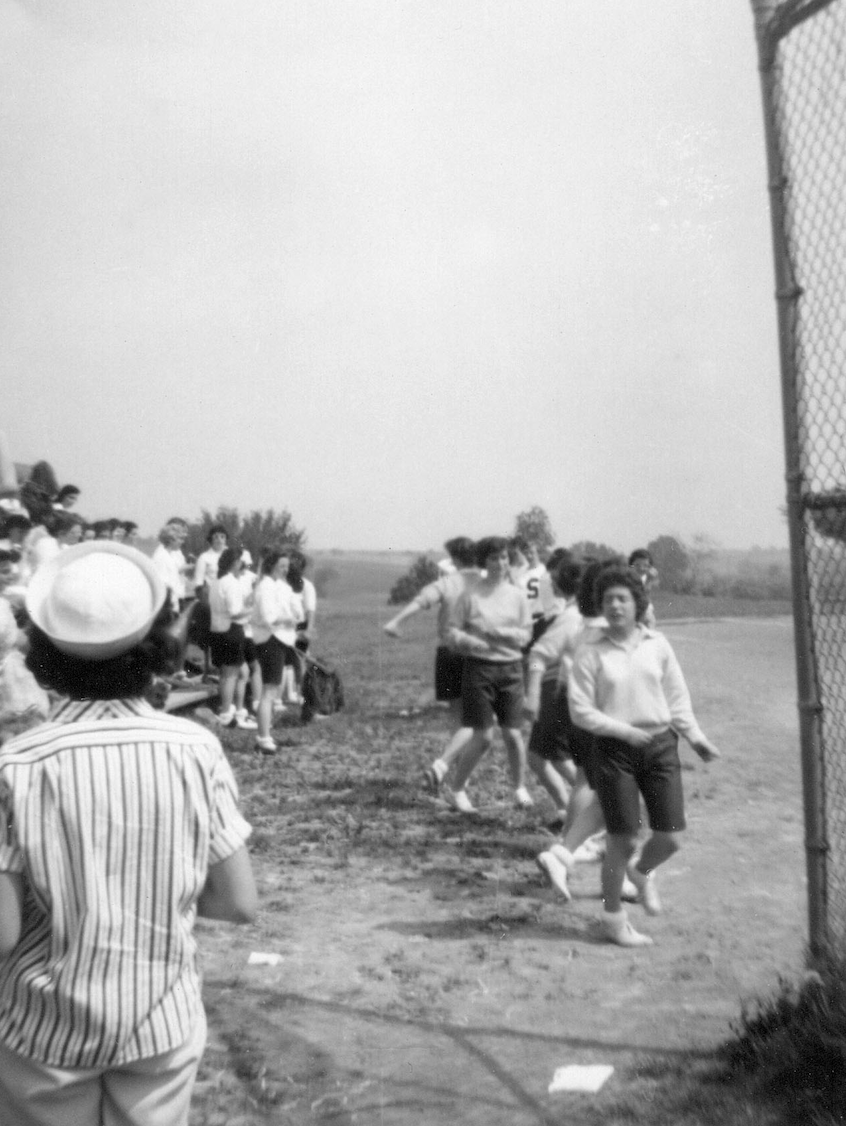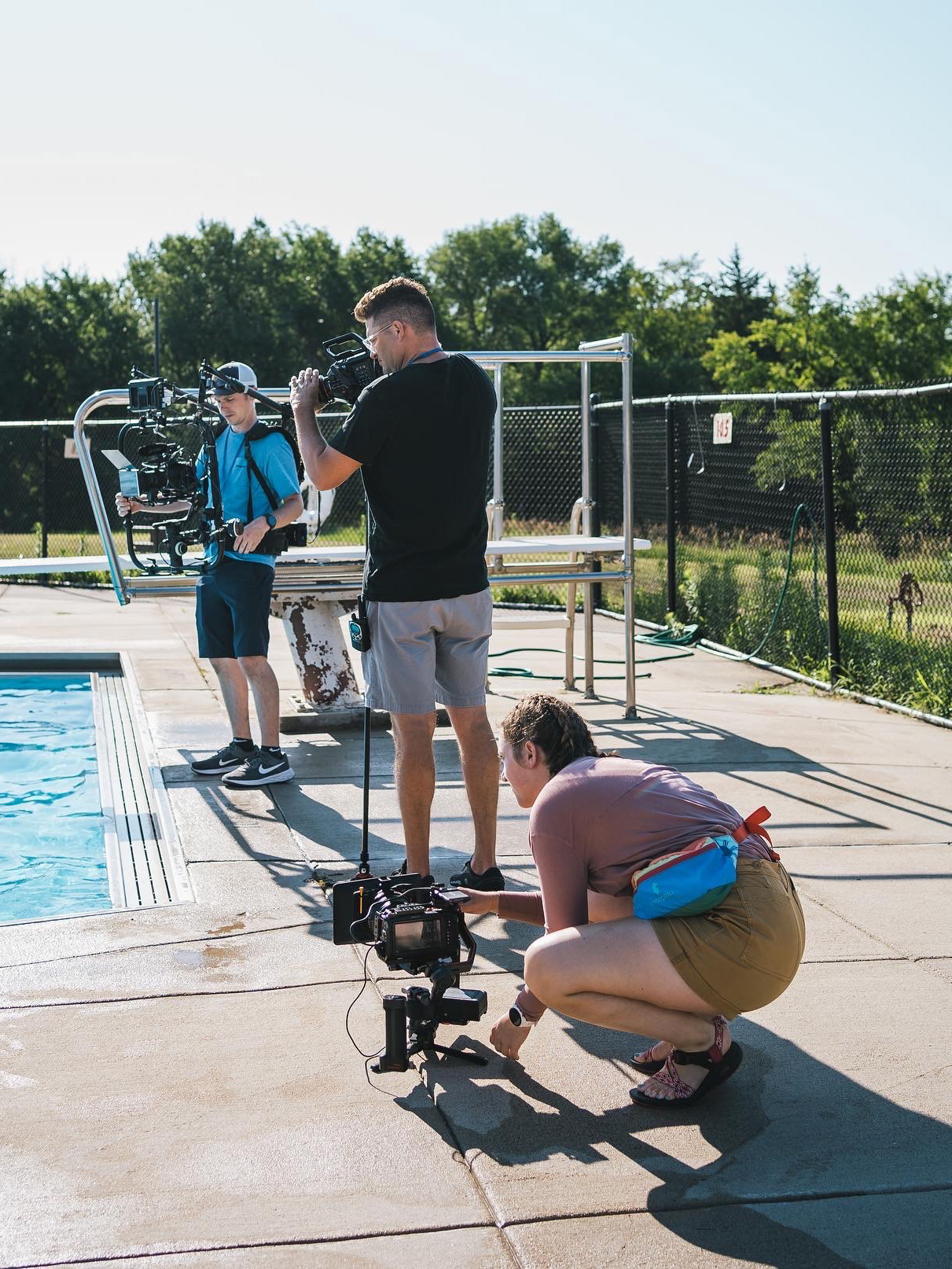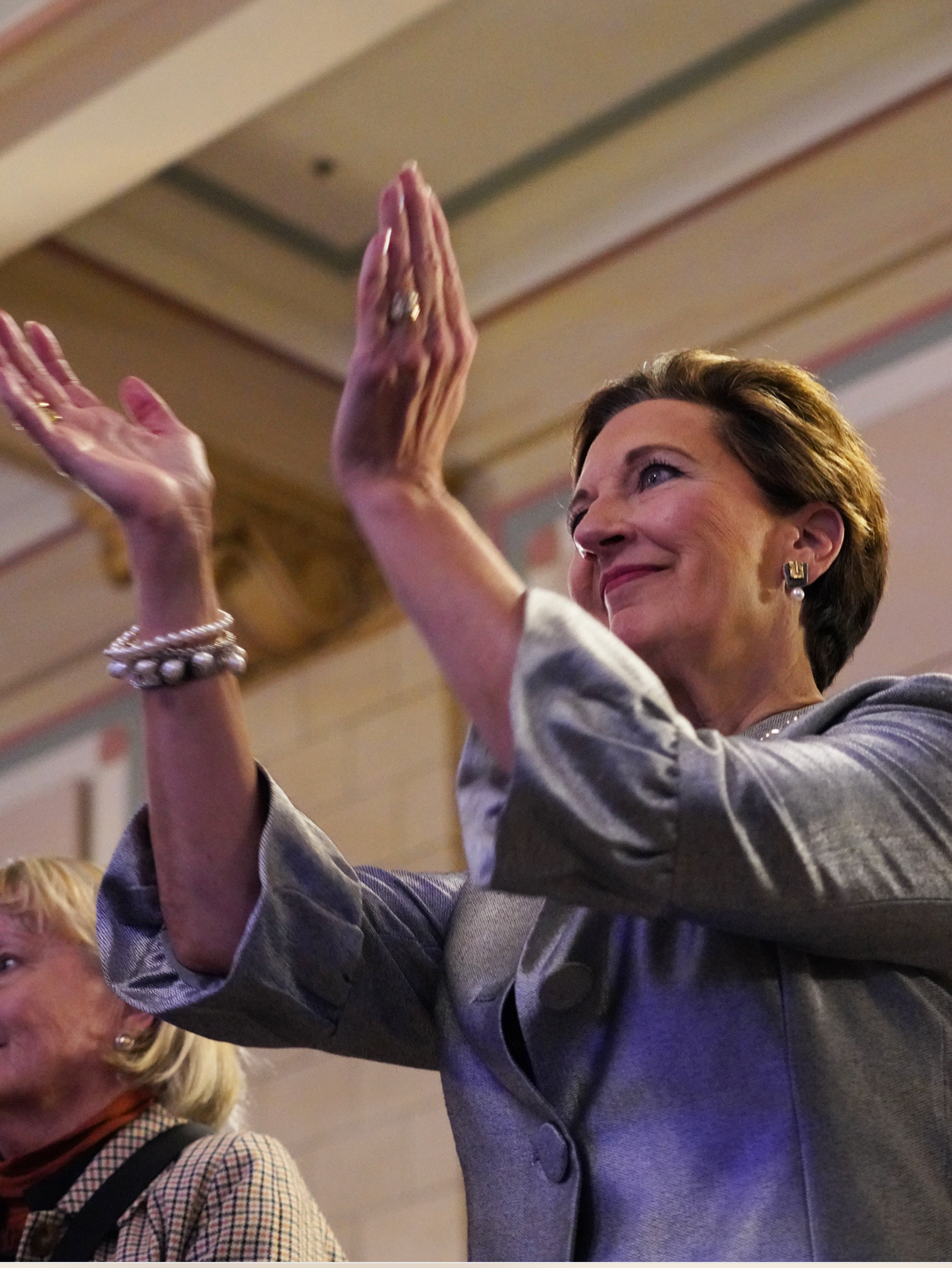Larry Yazzie dances in front of an audience at the University of Nebraska-Lincoln Student Union on October 12, 2022. Photo by Naomi Delkamiller.
Larry Yazzie - Minneapolis, Minnesota
Larry Yazzie, Monaka in the Meskwaki language, has danced everywhere from the 1996 Atlanta Olympics and The Pentagon to a coliseum in Jordan.
Yazzie, 55, is a two-time World Champion Native American Fancy Dancer based in St. Paul, Minnesota, who is telling the stories of his ancestors through social media, dance, education, and most recently, music. Yazzie’s versatility as an artist has brought his spirit and teachings to diverse individuals around the world.
“No matter where I go, I want to leave a piece of my teachings, my spirit,” said Yazzie in an interview ahead of a performance at the University of Nebraska-Lincoln. “I'm the medium of the creator to share the story of my people.”
Yazzie is scheduled for multiple performances in the United States through the rest of the year and is preparing to dance in Switzerland next August at an international folk dance festival. You can follow Yazzie’s journey here.
Yazzie’s expanding reach
Yazzie’s mission is to reflect the beauty of Indigenous traditions through artistic expression and encourage audiences to find pride in their own cultural heritage. For over 30 years, Yazzie has used dance as a means of sharing his story and has recently turned to social media to expand his reach.
With the help of his new social media manager Jessica Gawron, 34, Yazzie has increased his Instagram following from 64,000 to 99,000 in less than three months. Gawron and Yazzie met at a red-carpet fashion show in Minneapolis in September 2022 where she was working with a designer, and he was performing. She took videos of Yazzie on the red carpet and turned them into TikTok videos, one of which went viral with over 600,000 views.
Although Gawron has no formal social media training, she is a skilled video editor and experienced account manager. Her creativity and initiative impressed Yazzie and she is now working to help him expand his reach on Instagram and TikTok.
“We don't promote posts. It's literally just organic. Like we're just posting and he it's happening,” Gawron said. “I think the reason why they hired me was because of the fact that I wanted to make sure that he that his story and that his being authentic state.”
Gawron has been making strides to increase engagement by liking comments, responding to messages and consistently posting. Simple strategies like these have boosted Yazzie’s reach since Gawron was hired in September 2022.
“It’s important for him to be on social media because of what he’s doing. The education, the music, there’s nothing like it,” Gawron said, “He’s everywhere. He's reaching out to communities that may not understand right away. He's so comfortable in what he's doing and so confident that he's on the right path that I feel like he can walk in anywhere and just teach anything.”
Yazzie’s audience has naturally built up over time through events and exposure, but his talent and artistic versatility are what attract followers. Through the many mediums he has worked in and the spaces he has performed at, Yazzie has shared his culture with audiences that may not have experienced it otherwise.
A young start
As a child growing up in the Meskwaki Settlement near Tama, Iowa, dance was a refuge for young Yazzie, who was surrounded by children and teachers who did not speak the Meskwaki language at school. He experienced racism and discrimination, which brought feelings of shame and a loss of self-identity.
“I did not know what I had because I didn't see the outside world. I didn't see the outside struggles in other cities or other States or other countries. I just knew my world of the settlement and the local town of Tama,” said Yazzie, who never could have predicted dancing would put him on the world stage.
Dancing became his outlet and motivation to share his experience so that his children and grandchildren would not feel the shame he once felt. This form of self-expression and others helped him get through the darkest points of his life, and eventually to the brightest.
Since he was in his early teens, Yazzie has been competing in the powwow category and regularly performs three styles of dance in and out of competition settings. The Northern Traditional Dance tells the story of hunting, the Fancy Dance mimics the movements of the horse, and the Eagle Dance signifies prayer and honor. These dances have been passed down by Yazzie’s ancestors for centuries.
“My artistry brings a lot to me personally – it allows me to share and educate about my beautiful culture,” Yazzie said in a 2022 press release. “The stories and traditions are passed on through song and dance which is another way for keeping our culture alive.”
In 2003 Yazzie established Native American Pride Productions, a performing arts company that has taken himself and others around the world for nearly two decades. The company averages around 400 shows per year and honors the history and uniqueness of First Nations Peoples through performances, workshops, lectures, storytelling, dancing and more.
Musical collaborations
In a recent collaboration with Dirtwire, an American band duo that uses uncommon instruments to generate new sounds, Yazzie played a major role in the release of a new single.
While preparing for a performance, Yazzie overheard Dirtwire’s song "Stranger" and made a video of himself dancing to it on TikTok, tagging Dirtwire’s account. The band was impressed by Yazzie's creativity and energy, so the band reached out to form a connection. Evan Fraser, one of the founders of Dirtwire, later invited Yazzie to perform at their show in Colorado in September 2021.
“He’s on a mission to show the world his culture in a new way by dancing to different types of music that moves him,” Fraser said. “Dirtwire also creates by blending elements of different places and genres, so we have that in common with Larry and have connected on that.”
In July 2022 Dirtwire released a collaboration track with the Black Lodge Singers called “Intertribal.” The band invited Yazzie to perform a dance to the single and produced a video with him. Yazzie is also featured on the album cover in his regalia.
“Bringing all our vibrations together in the performances of “Intertribal” has been transcendent,” Fraser said, who is looking forward to having Yazzie on stage with the band at upcoming music festivals in 2023.
This collaboration is one of the many doors that has opened for Yazzie as he continues to build a strong social media presence.
Overcoming addiction
In the Meskwaki tradition, the Red Road is a phrase used to show a deep commitment to living by the Creator’s way through respecting others, oneself, and Mother Earth. It is a lifelong journey for many and at times, a rebirth.
“Through trials and tribulations, I've made some bad choices and alcohol led me to dark places,” Yazzie said. “I believe God the Creator gave me a second chance.”
Since Yazzie began his Red Road journey of sobriety two and a half years ago, the dark holes that once filled his life have disappeared. This past summer his son led him on his first Sundance, a ritual meant to test one’s physical and emotional strength in the name of healing. Together they went to South Dakota, where Yazzie meditated on a hill for 24 hours without moving, sacrificing comfort for a closer connection to the creator.
“When you sacrifice yourself, you're literally taking yourself out of your body and looking at yourself. You break yourself down and you build yourself back up,” said Yazzie. “To get to where I am now, I had to make sacrifices, I had to reconnect with the creator.”
Yazzie married his wife, Shawna Yazzie, following the Sun Dance ritual in August 2022. The pair met at an art gallery in Fort Collins, Colorado in October 2021 and have been together ever since. Yazzie said his sobriety and sacrifice helped unite them.
“She (Shawna) helped bring me back and look straight… she just reminds me who I am,” said Yazzie, who couldn’t imagine life without her.
Shawna Yazzie, 49, is of Chickasaw and Choctaw descent and grew up just outside of the Poarch Creek Reservation in Pensacola, Florida. She is the president of The NDN Companies and owns an environmental consulting firm. Shawna Yazzie also now assists Yazzie with contract work and travels with him to his performances as a partner and supporter.
“Where I'm weak, he's strong and where he's weak, I'm strong and together, we're just unstoppable,” Shawna Yazzie said. “I constantly remind him to not get distracted by the outside noise and to remember who he is, remember his name. And when he puts on that regalia, remember what it means and what it stands for.”
The eagle feathers, porcupine hair and buffalo bone on Yazzie’s regalia carry deep meaning. “They are not just dead animals, they have spirits, make the spirits come back to life,” Yazzie’s late father used to tell him. A strong connection with the beadwork, feathers, songs and flute music present in Yazzie’s dances symbolizes the common thread that connects humanity to the creator.
“I dance for the same reason each time I put on my regalia: my spirit. My spirit will tell the story, my dance will tell the story,” Yazzie said. “I'm the medium by the creator to share the story so that they can understand what spirit is about because a lot of people are lost.”
Coming full circle
Now living his life on the Red Road, Yazzie says he has come full circle; “To walk the Red Road is like a rebirth,” he said.
One element of his rebirth has been authenticity with followers about his sobriety journey. He regularly posts updates on his Facebook page, “Every day, I get closer to God. Every day, my will to do the right thing gets stronger,” he wrote in April of 2021, a year into his sobriety. In February he posted in celebration of two years sober. “It was 2 years ago today I pushed the last drink away. I got tired of being sick and tired!” Yazzie posted, with advice for others who wish to live a life of sobriety.
By sharing his story and culture, Yazzie has found an outlet to bring him out of his pain, something many people can relate to. Social media manager Jessica Gawron is proud of Yazzie’s resilience and wants to see Yazzie continue to be sober and tell his story.
“People need to hear that story because stories like this are rare,” Gawron said. “People don’t make it out you know, but he did. I believe dancing is what helps him, it’s what drives him.”
For Yazzie, walking the Red Road does not end in the decision to become sober. It is a commitment to keeping traditions alive and sharing his spirit with the world. Beyond dancing, Yazzie hopes to create a Native arts charter school in the future. He would also like to write a book and help other Native communities to bring arts into their schools.
Today Yazzie continues to perform a dance usually done by young teenage boys and men. This has become his own personal motivator as he wants to show his grandchildren that “grandpa can still dance.” You can book Yazzie for an event through Native Pride Productions here.
Portrait of Ariel Panowicz featured on her website. Photo by Natasha Wilson.
Ariel Panowicz - Omaha, Nebraska
For Nebraska-based photographer Ariel Panowicz, “Do you, Boo!” is not just a tagline, it is a motto she lives by.
Panowicz is a Nebraska native who received a bachelor's in photography at the Denver Art Institute in 2010. After a brief move to Los Angeles, California, she eventually returned home to Omaha, Nebraska where “the rent was cheaper, and traffic wasn’t as bad.”
Panowicz joined the Omaha arts scene as a creative director for multiple companies before taking a risk five years ago and committing to her photography business full time. “I just got to the point where, between my creative director role and my business, I just had too much work. It felt like the right time to go full force with my business,” Panowicz said.
With a wide variety of clients, Panowicz’s portfolio is diverse, but all her photos have one thing in common: color. “That's [color] what inspires me, it inspires me in real life. And so, I want to have that come through as true as possible in my work” Panowicz said, but she was not always this confident using color.
“Many years ago, I struggled with wondering if my work should look more like other people's work,” Panowicz said. Her self-doubt led her to scrap her style and try to fit in with the desaturated and moody edits she saw on social media platforms. "I edited some of my work to look like that to see if I was vibing with it and I just didn't,” Panowicz said, “and so after that I really knew what I wanted my style to be.” This was the moment she embraced who she was and accepted that: “I'm not for everyone... I happen to look on the younger side, I'm five feet tall, I'm small, and I’m a little kooky and funky.”
Panowicz is a photographer that is committed to doing what feels true and right to her. “It just felt natural for me to weave my business into it because I am a big part of my business. And I am my brand," Panowicz said, “I want people to know to get a vibe of who I am and my personality and what it would be like to have a shoot with me.”
So, what is it like to go on a shoot with Ariel Panowicz?
Alison Bickel, one of Panowicz’s clients, could not say enough about her experience. “She has an incredible eye for color, composition & light. On top of all that, she has this infectious personality that just makes you comfortable in front of her camera,” Bickel said, “It all comes together to create amazing images. Hire her. You won't regret it.”
For Panowicz, the best part of her job is connecting with people and bringing them joy. One photoshoot that stands out in Panowicz’s mind is a story she captured in 2019 of a grandmother who was a surrogate for her gay son. Panowicz photographed the journey from pregnancy to birth and the story went viral. “I just photographed it and posted it on my pages, and it just blew up from there,” Panowicz said. "Our phones were ringing literally 24 hours a day. It was crazy.” Her photos were published in The New York Times, BBC, and The Huffington Post, among other places.
One year after these live-giving photos spread across the world, something much deadlier followed: the COVID-19 pandemic. Panowicz was three months pregnant at the time and slowed down her business as a precaution, still occasionally doing outdoor shoots for families if everyone felt safe enough to do so. Since the onset of the pandemic and the birth of her daughter Penny Lu, her outlook on work life balance has changed completely. “Penny really forces me to slow down,” Panowicz said, “but I mean, it's like the best reason ever.”
Now, Penny is around 18 months old, COVID-19 is less of a mystery, and Panowicz is back to work, trying her best to strike a work and family balance. With more ideas than ever, Panowicz is planning to open a second business. “I am opening a creative event space called Luli Creative House,” Panowicz said, “I’ve been wanting to do something like this, and I feel like there is a great need in the Omaha community for a rentable creative studio.”
As a woman in the creative field, Panowicz has felt overlooked herself. Between worrying if she is charging too much or too little or if people will take her seriously, Panowicz has had to learn how to hold her own ground as a businesswoman. “I think just be bold and be you. Those two things come naturally to me now. But for many years, I tried to defy those parts of me, and it wasn't doing me any good,” Panowicz said, “It was doing a disservice to me and my business and my brand. And so, I have found that the more authentic I am to myself, regardless of who I'm with, or what room I'm in, is a good thing.”
With a whole team behind her, a supportive family, and a secure location in downtown Omaha, Panowicz is on her way to opening the doors of Luli and welcoming a new wave of creativity in the city.
“The creative community here is special. It's unique. It is overlooked, but we're changing that,” Panowicz said.
Ultraviolet light is being used to decontaminate medical supplies at the University of Nebraska Medical Center in Omaha. Calla Kessler/The New York Times | Reprinted with permission.
Calla Kessler - Omaha, Nebraska
Omaha native and New York Times photography fellow, Calla Kessler, 23, returned to Nebraska in mid-March. She left her Brooklyn apartment to use her skills as a visual journalist to document the COVID-19 pandemic in the Midwest.
Kessler’s most recent assignment from her editors was to capture the University of Nebraska Medical Center’s (UNMC) response to the shortage of protective medical equipment. The national news outlet was familiar with UNMC because of the center’s work with Ebola back in 2014 and specifically asked Kessler to photograph their efforts to reuse surgical masks by cleaning them with ultraviolet (UV) light.
Although the procedure violates established regulations from the Center for Disease Control and Prevention, recently added guidelines from the agency say quote, “as a last resort, it [unapproved masks] may be necessary.” Which includes UNMC’s decontaminated masks.
However, documenting this effort brought challenges. “This may be an example of what it looks like when my editor is in New York and doesn’t know what it looks like on the ground—it can lead to some miscommunication,’” Kessler said after her visit to UNMC on March 20.
The UV lights being used at the medical campus are blinding, almost impossible to look at, and known to cause radiation in the body- which is why Kessler could not be in the room to photograph when the UV lights were turned on. “I didn’t realize I wouldn’t be able to be in the room and that was kind of a surprise,” Kessler said.
She first tried composing the shot from a window and then across the hall, until she decided to set up her camera and cross her fingers. “I would go into the room before they turned the lights on and I would set my camera up on a desk and compose my shot,” said Kessler. “Then I would leave it on a timer and run out of the room. They would start up the UV light, I would wait and eventually go in to check my images.”
For a photojournalist who wanted to deliver, Kessler described the experience as “scary.”
“It was hard not knowing what the shot would turn out like,” she said, “but my camera got super cleaned [from the light] which was cool!”
Returning home from the photography shoot at UNMC, Kessler said, “I changed my clothes, threw them in the wash, I disinfected all my gear, my shoes, took a shower and that was that. I didn’t waste any time.”
After witnessing UNMC’s attempt to clean masks, Kessler said, “This process- it works. People just have to get past the idea that the mask has been used before. UV light kills things. That’s why I couldn’t be in the room.”
Overall Kessler believes this pandemic could easily become “the story of a generation.” She is determined to document the Midwest perspective and hopes that people will gain a newfound respect for those who bring information to the general public—they too are on the frontlines.
Her images were eventually published in an online article from The New York Times that addressed UNMC’s efforts to use UV light to clean and reuse masks. “I am fortunate to be at home with my family & still contribute to the @nytimes coverage of the COVID-19 pandemic,” wrote Kessler in an instagram post, “I’m proud of Nebraska Medicine’s innovation that will relieve the problem of dwindling medical supplies. ”
Calla Kessler is now pitching some new story ideas of her own and has once again found herself reporting the Omaha perspective. More of her work can be found here.









